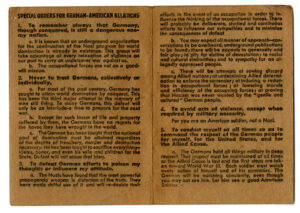This small pamphlet (5” x 7”), designed to be tucked inside a helmet‐liner or to be inserted into a wallet, instructed U.S. troops about the Army’s non‐fraternization policy. The non‐fraternization policy, which was officially announced after American troops first entered German territory in September, 1944, informed soldiers how they were to conduct themselves with German civilians. “As conquerors,” General Omar Bradley wrote, “we must now consider our relations with the people of Germany.” Bradley commanded his soldiers to be “fair but firm” with the German people, but never to trust or associate with them. While the American army had defeated German soldiers on the battlefield, it was also important to defeat and discredit them in their homeland: “You personally must prove to the German people that their acceptance of Nazi leadership is responsible for their defeat and that it has earned for them the distrust of the rest of the world.”
Goetz expressed doubts about the wisdom of the non‐fraternization policy several times in his diary. At the end of April, 1945, he wrote: “I have been trying to reconcile myself to this business of NonFraternization but although I approve of it, theoretically, I cannot see it working in practice. A few modifications would improve it materially. What are we to gain by being harsh with children? They have had enough of misery and hardships. By treating them kindly, they will have little trouble making comparisons between us and the super race. We would not be the ones to suffer.” Vernon Goetz Diary, 19‐26 April, 1945. For a good discussion of the non‐fraternization policy, see Ann Elizabeth Pfau, Miss Yourlovin: GIs, Gender, and Domesticity during World War II (New York: Columbia University Press, 2013, c2008), ACLS Humanities E‐Book, Chapter 3.
Insert 14a— Thursday, December 28, 1944 (Page 1)
Tuesday, 18 April, 2023
